Updated May 13, 2002
By Pete LaFleur
Steve Stanley didn’t think he ever was going to get at a hit on the Division I level, not after enduring a frustrating 0-for-17 start to his college career.
More than 200 games later, a player often overlooked due to his size (5-8, 155) is standing tall as one of the nation’s premier college baseball players while rewriting the Notre Dame and BIG EAST record books.
Stanley’s career accomplishments are all the more noteworthy when considering the journey, including the inauspicious start to his Irish career. That five-game slump – spanning a game vs. James Madison in Miami, three games at Florida International and a matchup vs. Missouri in New Orleans – saw Stanley reach base just twice (on walks), with no stolen-base attempts, one run scored and six strikeouts.
In his next game versus the host team at the New Orleans Invitational, the first-year centerfielder followed Alec Porzel’s leadoff triple with a sacrifice fly for his second RBI of the season. One inning later, his long-awaited single helped put six runs on the board for a 10-1 lead – en route to a 14-11 win as Notre Dame began to battle back from its 1-4 start.
With the game situation including a runner on third base and one out, Stanley’s chance at a first hit took on added significance when he jumped out to a 3-0 edge in the count. Surprisingly, head coach Paul Mainieri gave his struggling rookie the “green light” to swing away at a pitch in his zone.
“The time was right to build Steve’s confidence and that only was going to happen if he got a hit in a clutch situation,” remembers Mainieri, now in his eighth season as the Irish skipper.
Stanley did not let the opportunity slip away, drilling the next pitch over the second baseman’s head, motoring to second when the rightfielder fumbled with the ball and adding his first stolen base for good measure.
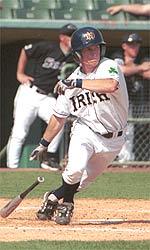
Some 900 at-bats later, Stanley’s career hit total (356) has grown within range of occupying a spot among the all-time Division I leaders, with his .384 career batting average ranking third in the Notre Dame record book.
“That was a great learning experience and it really helped me and the other seniors stay focused after the tough start this season,” says Stanley, in reference to the stunning 9-10 start encountered by the 2002 squad.
“When I went 0-for-17, I really questioned whether I had the ability to play on the Division I level. All of the freshmen were shellshocked with how the season started and we didn’t know if we’d be able to be a good team.
“That’s why I’m so grateful coach Mainieri gave me the chance to get that hit. It really put me back on track and I started believing in myself.”
Mainieri had encouraged Stanley not to set personal goals prior to his first season, as they might end up being too low or too high. “He wasn’t sure how I’d do at the plate but he said I’d always be in the lineup because of how I played center field,” recalls Stanley.
“He said I could hit .150 and still be playing – but after that rough start, he came over and joked that he didn’t really mean it and it would be OK for me to start getting some hits. It was a good time to laugh about it, but I still had my doubts. It was a huge weight off my shoulders to finally get the hit.”
One of the more impressive statistical notes from a career brimming with highlights is the fact that Stanley’s worst hitting “slumps” since that ominous start were a pair of three-game hitless slides during that same ’99 season. The rest of his career – including all of the 2000-02 seasons – has yet to see the consummate battler go more than two consecutive games without a hit (with a total of only four two-game slumps during the past three seasons).
ONE OF A KIND
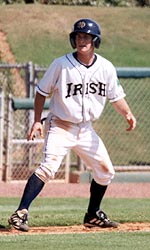
Stanley’s impact on the game is impossible to quantify, due to his defensive and baserunning abilities, coupled with a multiple-threat bat and tremendous baseball smarts. An accomplished bunter early in his career, a stronger Stanley now can just as easily drive the ball into the gaps while still hitting effectively to all fields and in all situations. His presence on the basepaths provides a pesky distraction to opposing pitchers – and an altered pitch selection for hitters behind him – while Stanley’s textbook defense regularly takes hits off the board for baffled opponents.
“Show me a player in college baseball who does more things for his team on a consistently high level and I’ll be the first to shake his hand,” says Mainieri, who will trumpet Stanley’s credentials as a national player-of-the-year candidate to anyone who will listen.
“I don’t think you’ll find that player because there’s only one Steve Stanley and his impact on this program is simply amazing. I’m reminded of that every time I think about what the past four years would have been like without him. The great thing about the kid is that he has been so consistent but also is so driven to always get better and better.
“He has a lot of great attributes but his heart may be the most important, because there are a lot of players with great talent that never come close to making the impact that he’s made.”
Baseball America’s midseason report ranked Stanley as the nation’s “best player under 5-10” while also dubbing him the “Roy Jones of college baseball,” in terms of being the game’s top player “pound-for-pound.”
The size issue always has been a battle for Stanley and will continue to be as he attempts to play at the next level next season. His high school coach would not allow Stanley to play on the varsity squad as a freshman, providing one of many doses of motivation thrown his way over the years.
“I’ve always been challenged by people because of my size … and I’ve always proved them wrong,” says Stanley, who fittingly also was an accomplished point guard on the Worthington Christian basketball squad.
Heading into the final regular-season week, Stanley has extended his string of consecutive starts to 238 (every game of his ND career) – which ranks as the second-longest in Division I history and the longest in 15 years, since Arizona’s Chip Hale started all 255 games of his 1984-87 career.Stanley also needs 10 more hits to earn a top-five spot on the Division I all-time hits list.
RECORD BOOK REGULAR
Just one year removed from the end of the most-decorated career in Notre Dame baseball history, Stanley has matched the type of numbers posted in the Irish record book by righthanded pitcher Aaron Heilman. While Heilman posted a 43-7 record and blew away the team record for career strikeouts (425, well ahead of the 315 by David Sinnes from ’90-’93), Stanley’s 356 career hits are 60 better than the previous Irish record (296, by ’89 grad. Pat Pesavento).

Stanley also has bested Pesavento’s record for consecutive games played (204) while his 235 runs scored rank second, 11 shy of Pesavento’s record. Stanley’s 928 career at-bats have knocked former teammate Alec Porzel (860) from the top of that ND list, with Porzel’s record for games played (239) and J.J. Brock’s games-started mark (238; ’90-’94) likewise within Stanley’s sights. He also ranks as Notre Dame’s all-time leader in stolen bases (113) and has totaled nearly twice as many walks (116, good for 7th in ND history) as strikeouts (61) in his four college seasons.
No player in the history of the BIG EAST Conference has totaled more hits (151) or scored more runs (108) in BIG EAST regular-season games than Stanley, who recently bested the old records held by former Rutgers teammates Darren Fenster (138 hits) and David DeJesus (93 runs).
FINISHING STRONG
Not content to rest on the laurels of his career accomplishments, Stanley has fashioned a final season that serves as a perfect cap to his four years with the Irish.
He entered last week ranked eighth in the nation for batting average (.457, now .459) and has walked 28 times to help produce a .527 on-base percentage. Both of those averages are on pace to challenge the ND records still held by 1993 senior outfielders Edwin Hartwell (.447 batting) and Eric Danapilis (.531 on-base). Stanley has posted three double-digit hitting streaks in 2002 while going hitless in just six of 50 games this season (he has hits in 51 of his last 57 games with the Irish).
“I have a lot more confidence in my abilities and a lot of that comes from coach Mainieri letting me play my style,” says Stanley. “I’ve become a better all-around hitter, I’m stronger and am hitting the gaps more. I just have more focus and am really putting the bat on the ball.
“I had no idea I’d have this type of season. I’ve been more aggressive in the count and have never seen the ball as well as I am now. I just have a lot of confidence up there.”
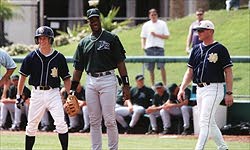
It’s a true testament to a player’s lofty status when even failure produces great statistical notes. Such was the case two weeks ago in the annual game versus Michigan, held at a facility (Fifth third Ballpark, formerly Old Kent Park) where Stanley had batted 9-for-15 in his the previous three “Baseball Bashes” versus the Wolverines. Apparently, he doesn’t care for the stadium’s new name, as Stanley’s rare stat line vs. UM included just the third 0-for-5 game of his career (and first in 195 games) while he had multiple strikeouts (2) for the first time in 95 games.
His longest “slump” of the season has been six consecutive at-bats without a hit while a recent 21-game stretch saw Stanley never go more than two at-bats without a hit. And his amazingly-low total of seven strikeouts (one-fourth of his walk total) factors out to 33 plate appearances per K.
One of Stanley’s best “friends” in the Notre Dame baseball program – the “Iron Mike” pitching machine – isn’t the type to hurl insults at the Irish captain, but it will throw him an occasional curveball. The pair spends quite a bit of time together in Notre Dame’s three-year-old indoor hitting facility, adjacent to left field at Eck Stadium.
“I love having the use of our indoor facility. You can focus on certain situational batting and it really allows you to get in a groove. There’s no question it’s played a big role in my improvement as a hitter,” says Stanley, whose yearly batting average has jumped 40-60 points every season (.326-.362-.400-.459).
A leading contender to repeat as BIG EAST player of the year, Stanley could receive the award without winning a single BIG EAST player-of-the-week honor this season. His amazing consistency in the first 12 weeks of the season has seen Stanley hit at least .285 in every week (above .475 in six of the last seven) – with 10 weeks above .333 and seven at .500-plus – and his average has been above .400 since the seventh game of the season (above .450 since April 11, for the last 21 games).
Stanley’s BIG EAST credentials include league-leading totals in overall batting average (.459), on-base pct. (.527) and hits (90), plus second in runs (57), third in stolen bases (29), sixth in total bases (111) and seventh in walks (28). He also ranks second in the BIG EAST for conference batting avg. (.457) and on-base pct. (.514).
Longtime Virginia Tech coach Chuck Hartman has been impressed with Stanley’s play during the six games his Hokies have played versus the Irish since joining the BIG EAST in 2001.
“Steve is certainly one of those special players who can have an impact on a game. From the other coach’s standpoint, he’s a guy you dread seeing come to the plate,” says Hartman, who has seen his share of college baseball in 43 seasons while ranking third among active coaches for career Division I victories.
“He can bunt, run, hit and play terrific defense in the outfield … he’s just a complete player. As an opposing coach, Steve is the guy you don’t want to let beat you. But, a lot of times, he still does. From what I’ve seen, he looks like a coach’s dream. I’d like to coach a guy like him who has so many tools.”
TOUGH LOVE
Stanley joined many of his teammates in taking the 2002 team’s 9-10 start as a personal challenge to get better – in a hurry. And with his teammates falling around him due to an assortment of early-season injuries, Stanley responded by somehow elevating his game while maintaining his trademark consistency.
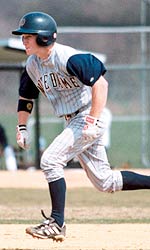
“The start this season brought back some tough memories from our freshman season. But we knew from that experience that there still was a lot of baseball left to be played and we had the chance to salvage the season,” he says.
“The fact of the matter is that we did not get the job done with the bats early in the season – we simply didn’t hit in the clutch. It’s true we were hit hard by a lot of injuries and had to adjust to not having veteran pitchers like Aaron Heilman and Danny Tamayo from last season. But we still had a lot of veteran hitters, myself included, who had chances to win some games and we didn’t get it done. That’s obviously changed.”
Stanley – whose reputation as an all-out competitor even extends to clubhouse ping-pong games – warned his teammates after the 9-10 start that his leadership style might include some unkind words, in hopes of kicking the talented Irish squad back onto the winning track. With preseason All-American Brian Stavisky lost from the lineup early in the March 28th doubleheader at West Virginia (he was hit with a pitch and would endure his second nine-game rehab from a 2002 injury), Notre Dame responded by taking the second game from WWU – launching the Irish onto the current 25-3 run.
The comparisons to the 1999 season are certainly found in the numbers, as that 1999 team opened 5-6 before winning 21 of its next 23 en route to a 41-15 regular-season record and the right to play host to the first NCAA Tournament games at Notre Dame in 40 years.
Stanley’s trademark intensity is nothing new for his classmates, who witnessed it firsthand during a seemingly routine intrasquad scrimmage in the fall of 1998. Stanley was coaching third base that day when fellow freshman Matt Strickroth – who, at 6-for-4 and 230 pounds, stood eight inches taller and weighed nearly 80 pounds more – came barreling into the bag and tumbled into his smaller classmate.
“Matt was upset that Steve didn’t tell him to slide, and Steve came right back at him by telling Matt that he should have taken responsibility for himself,” recalls senior catcher Paul O’Toole, who has known Stanley since their days as 14-year-olds on the Akron-based Mainstreet Muffins summer team.
“All of a sudden you had the biggest and smallest guys on the team about to go at it, and (catcher) Jeff Wagner had to lumber down there and break things up. But that’s how Steve has been ever since I’ve known him. It’s an important part of his personality and his game. He wouldn’t be the type of player he is without that intensity and competitiveness.”
CATCH WITH A FRIEND
Stanley credits his father, Mike Stanley, with much of his development as a player.
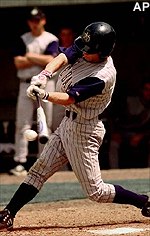
“My dad knows me better as a player than anybody else and has been a great teacher and friend throughout my life,” says Stanley. “He can watch me play a game and will talk to me about things I did right, things I did wrong. He’s just made a great impact on the player I am today.”
The lessons from his father began when Steve was nine years old, as he quickly picked up the art of outfield defense.
“My dad taught me how to go back on a ball, not backpedaling, and then how to find the wall and find the ball,” says Stanley, whose eight career errors include just one this season, a controversial dropped-ball call at Seton Hall. “I’ve always taken a lot of pride in my defense.”
The typical Stanley practice drills took place at a nearby school, with the high-energy youngster dragging his dad down the street for a lengthy game of catch. Mike Stanley would lob balls to his son, preparing him for the tough catches.
“That was the first time I started to notice that Stephen has an abnormally high work ethic, because he never once asked to stop,” says the elder Stanley. “My arm would start getting tired, so I’d try to make the throws even harder than usual, but he’d still run them down. Finally, I’d have to be the one to stop because my arm was so sore.”
Steve’s mother Sharilyn often would become part of the practice regimen, with her unorthodox throws providing an added challenge for the eager fielder.
One of the more subtle aspects of Stanley’s effect on the game is the role his defense plays in determining the approach of his team’ pitchers. Heilman – a four-year All-American and first-round draft choice of the New York Mets – readily credits the speedy centerfielder with aiding his own success.
“It was great having a guy like Steve out there, because you knew you didn’t have to throw the perfect pitch every time,” says Heilman. “Even if a guy puts a good swing on it, he runs it down. He takes a lot of hits away form the opposing team.
“It’s definitely a confidence booster to have an outfielder with such great speed and sense of the game. He goes that extra mile to make a diving play and it gets to be routine- it’s a shock the few times that he can’t get to a ball. He takes away the hard-hit balls to the gaps but also the little bloop hits, because he loves to play shallow. You don’t have to worry about jamming a batter and having a hit sail into shallow center, because he’s there to catch it.”
CLASSIC MOMENTS
The past two seasons ended with Notre Dame agonizingly close to advancing past the NCAA regional round. In each instance, Stanley played a leading role on a team that battled down to its last out.
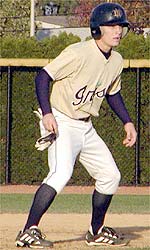
Notre Dame’s 2000 NCAA appearance came at one of the premier venues in all of college baseball, Mississippi State’s Dudy Noble Field. Known for its knowledgeable fanbase that numbers well over 10,000, Dudy Noble’s most unique attraction is the “Leftfield Lounge” – a seating area that has grown to include the entire outfield viewing space. Plots in the “Lounge” are sold as season passes and most fans construct various forms of approved scaffolding and vehicles to create a unique outfield scene, complete with an army of barbecues that send their smoke and aromas into the hot Mississippi air.
The Irish entered this setting as the third seed among four teams, rallying in their first game to beat Tulane before dropping an 8-1 game to the host Bulldogs. Notre Dame then again had to rally versus the Green Wave, after a lengthy tornado-induced delay that pushed the game well past midnight.
Hours later, the Irish returned to Dudy Noble and rode a three-hit masterpiece from Tamayo while handing MSU a rare shutout loss, 7-0. The Bulldogs then won an epic title game, 10-9, ending on a solo home run in the bottom of the ninth – with Stanley racing into the wall as he chased the game’s final hit, before crumpling to the ground in dismay.
Many of the Irish players won over the Dudy Noble faithful, due to their hustling play and undying spirit. Stanley, in particular, became the fan favorite for the denizens of the Leftfield Lounge. And as he trudged back trudged back to the losing dugout, the Irish centerfielder was comforted by numerous MSU fans who had jumped the centerfield fence to console one of their new college baseball heroes.
“The whole experience of that regional remains the best experience I’ve had in baseball,” says Stanley, who was so nervous prior to the first game vs. MSU that he was unable to eat prior to the game and later was forced to leave the game due to heat exhaustion (the only time in his ND career that he has missed any time due to injury or illness).
“Most people didn’t think we could go down there and win but we made a lot of believers in Notre Dame baseball. I can’t really put the whole experience into words. The people were so classy and they really cared about the other team. The tapes of those games are something that I’m going to love showing to my kids and grandkids some day.”
One highly-respected observer from the opposing dugout came away impressed with the heart and soul of the Irish squad.
“Steve is an exciting and outstanding player. He’s an impact player on any ballclub,” says former Mississippi State head coach and current University of Florida skipper Pat McMahon, whose MSU squad also opened its 2001 season with a pair of games at Dudy Noble versus the Irish.
“He made several outstanding defensive plays against us last year and in the regional and can be an outstanding offensive player. He’s a go-to guy.”
Stanley’s .363 batting average during his first three seasons with the Irish included a lofty .434 (23-for-53) in 13 NCAA regional games, with 16 runs scored, five RBI, four stolen bases, seven walks, a triple, two doubles and just four strikeouts. He hit 7-for-19 and scored five runs at the Starkville Regional, but possibly his biggest postseason hit came one year later, at Notre Dame’s Eck Stadium.
With his team down to its last out in a 2001 NCAA elimination game vs. UC Santa Barbara – several hours after losing in heartbreaking fashion to Florida International – the sparkplug of the Irish squad still had plenty of fight left in him. So he worked ahead in the count vs. All-American James Garcia before driving a 2-1 pitch into center field, with O’Toole motoring home from second base as the Notre Dame bench erupted with the game-tying score (10-10). Stavisky’s 10th-inning home run added the winning run and the Irish went on to beat FIU, 5-2, before losing to the Panthers in the final game, 5-4.
Stanley was all smiles, yet still all-business, in the postgame press conference after the dramatic win over UCSB. “I live for times like this,” he told the media, in reference to his game-tying hit.
“I wanted to be that person up there in that situation. I just hoped that Joe (Thaman) would either walk or get a hit to give me a chance. When I got the 2-and-1 count, I smiled at the plate because I knew that I was going to do it.”
As he nears the end of his final season, Stanley now hopes for just one last chance at creating some more NCAA magic.
SENIOR PRIDE
As a returning All-American and record-setting performer, Stanley is the most visible member of an eight-member senior class that has been a major force in the program’s recent rise to a spot among the nation’s elite, with trips to the NCAAs in each of the previous three seasons. The first four seasons of the Mainieri era had seen the Irish program manage just one trip to the NCAAs, ending up on the proverbial bubble in ’95, ’97 and ’98.
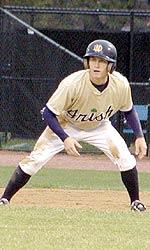
The current senior class made its debut in a college game during a rare exhibition matchup versus Michigan State, at Lansing’s Oldsmobile Park in the fall of ’98. The game provided a glimpse at the future of the program, with three of the freshman starters from that game going on to be four-year starters with the Irish. Stanley fittingly scored all the way from first base on a single by team leader Brant Ust, with Stanley motoring around the bases as his oversized batting helmet strained to stay on the head of the fleet-footed newcomer.
The three players from that game who went on to become four-year starters – Stanley, O’Toole and third baseman Andrew Bushey – already have earned their place in the program’s history as the only Notre Dame classmates ever to start 200-plus games. Their eye-popping combined numbers include: 665 games played and 655 started; 805 hits in 2,397 at bats for a .336 combined batting average; 41 home runs, 26 triples and 139 doubles; 381 RBI and 530 runs scored; 173 stolen bases and 271 walks (to 218 strikeouts).
Stanley, speaking for all of his classmates, takes great pride in the strides made by the program during the past four seasons, with the Irish winning nearly 75 percent of their games in that stretch (174-63-1) while serving as the host team for NCAA regional action in 1999 and 2001, to go along with the program’s first No. 1 national ranking in ’01. The eight seniors have played major roles in those 172 wins, with that group combining for 1,233 games played and 955 starts during the past four seasons.
“I have great pride in the Notre Dame baseball program and am driven to keep that level of excellence this season,” says Stanley. “Our first goal still is to make the BIG EAST Tournament and try to win it, but then we want to make another run at Omaha and the College World Series. I hope that never stops being the goal of this program.
“I’m really sad that I’m going to be leaving, but I know that I’ll keep in touch with these guys and I’ll always be very supportive of the great Notre Dame baseball program.”
CAPE COD SUCCESS
Stanley’s exploits as a college player have not been limited to a Notre Dame uniform. Most notably, he was an all-star performer in the prestigious Cape Cod wooden-bat league during the summer of 2000. Playing alongside O’Toole as the starting centerfielder and leadoff hitter for the Brewster Whitecaps, Stanley led his team to the Cape Cod League title while winning the league’s batting title (.329) and earning summer All-America honors.
The head coach of that Brewster team, current USC pitching coach Dave Lawn, views Stanley as a serious contender for national player-of-the-year honors due to his widereaching effect on the game.
“Steve is the best leadoff hitter I’ve seen on the college level in my 16 years of coaching,” says Lawn, who was reunited with Stanley and O’Toole earlier this season in an ND-USC matchup at the Round Rock (Texas) Express Classic, with Stanley’s 3-for-5 day including a walk, a pair of doubles, two runs scored and an RBI in that 15-8 comeback win.
“When we played Notre Dame, I knew exactly how to have our guys pitch Steve but we still couldn’t get him out. If you miss what you’re trying to do by even a half an inch, he’s going to beat you.”
Stanley’s batting-title season in the Cape was accompanied by total confidence from his coach. “The amazing thing is that I never had to give Steve a sign all season,” says Lawn. “He always knew the situation and knew what he had to do – when to take a few pitches, when to lay down a sacrifice bunt, when to steal. Having him on your team is like a lesson in Baseball 101.”
Lawn also has his own take on Stanley’s defensive skills. “His arm strength doesn’t mean nearly as much, as long as he an get to the ball quick, get rid of it quick and send in a low throw to the cutoff man. The status of his arm ‘plays up’ because of those things,” says Lawn.
“Steve’s style is to play very shallow to take away the short hits and guys would launch ‘S.K.U.D.’ missiles that he would just run down. When my father-in-law saw our games, he said Steve plays just like Joe DiMaggio used to play, and he goes way back to the days when DiMaggio played in the Pacific Coast League.”
Lawn’s discussions of Stanley’s attributes include a telling anecdote about the player’s character. With Brewster’s playoff position locked up heading into their final regular-season game, Stanley – who had started every game as the leadoff hitter – faced a Ted Williams-like dilemma. He led teammate Jack Headley atop the Cape batting charts and had the option of sitting out the finale, with no chance of losing the battle title. Instead, Stanley insisted on playing and thus risked losing the impressive distinction of leading the nation’s premier summer league in batting.
“Steve could have sat out that last game and won the batting title anyway,” says Lawn. “But he wanted to play, went out and got three ‘knocks’ and won it the right way.”
BEYOND THE DIAMOND
The depth of Stanley’s personality extends well beyond the baseball field. Known for his high-energy attitude and propensity for practical jokes, the Irish co-captain also has a softer side that is based in his spirituality and his recent marriage to high school sweetheart Brooke May.
“I’ve definitely become more mellow off the field and that’s due in large part to being married and to a talk that coach Mainieri and I had before the season,” says Stanley. “He told me that I would have to make some adjustments in order to play at the next level. Even in the course of a game, you would have seen me throw my helmet and yell at umpires a lot more in the past. Now I just let the game come to me, and it’s worked out great.”
Stanley’s closest confidant on the team has been Bushey, with the pair rooming together on every roadtrip of their careers.
“Steve does so many things for this team that you can’t put on a stat sheet,” says Bushey. “Even the off-field stuff like his energy, the rest of the guys just feed off of it and he’s the life of the bus when we are on the road. You’d never know those type of things by watching him play, but he’s a very unique teammate who makes an impact on you in so many ways.”
Bushey and Stanley have become kindred spirits, capable of analyzing each other’s game with striking efficiency.
“We know each other almost as well as we know ourselves, and I always can tell him what he did wrong in a game and he’ll tell me the same thing,” says Bushey.
“We always analyze a game when we get back to the hotel and it’s amazing the things we notice about each other’s game. We can be totally open with each other and I know that’s played big part in how we’ve both improved as players.”
Stanley’s “softer side,” as O’Toole likes to call it, was in full bloom during his wedding festivities, in early January. One portion of the reception included a “Wedding Story” video that showed the couple enjoying their time together in the days leading up the ceremony.
“At one point on the video, Brooke started singing her favorite song, ‘You Say It Best’ by Anne Murray, and then Steve joined in,” says O’Toole, with a laugh. “I think he has the worst voice I’ve ever heard but that was something he wanted to do for her. It showed a lot about Steve’s personality. He isn’t afraid to show that side of him.”
Stanley’s inner peace is based in his strong spirituality. “My belief in God and his purpose for me gives my life a great sense of perspective,” he says. “I’m very devoted to beliefs and live my life the way I think it was intended. I also know that God has given me a gift and feel it’s my responsibility to share that gift with others by being the best player, teammate and friend that I can be.”
WHAT ALMOST WASN’T
As Stanley looks back on his Notre Dame career, he knows that the O’Toole family deserves some of the credit for him ending up at the Northern Indiana campus. O’Toole and his father Philip were visiting Notre Dame in the summer of 1997, when the elder O’Toole mentioned to former Irish assistant coach Cory Mee that he should take a look at a dynamic centerfielder who had played summer-ball with his son.
With the Irish already hoping to find a centerfielder on a par with former all-star Scott Sollmann (1994-96), Mee headed to Lexington, Ky., for a Team One Showcase in which O’Toole and Stanley were likely to play.
“There were five or six games that weekend but I only got to play in one,” recalls Stanley. “They had this unique format where you could be a designated runner and I stole second and third three times, for six stolen bases. I think it made an impression on Cory and that basically led to me being recruited and eventually signed by Notre Dame.”
Stanley knows that some observers believe he could have played for a lesser program but been more of the marquee player, not having to share the spotlight with the likes of Wagner, Ust, Heilman, Porzel, O’Toole and Stavisky. Of course, he has his own take on that scenario.
“If I had stayed in-state and played at a school like Miami (Ohio), Bowling Green or Dayton, I would not have come close to being the type of player that I am now,” he says.
“And that’s mostly due to coach Mainieri, because he truly gets the best out of his players. He has allowed me to excel while playing my game, always has instilled confidence in me and has given me great direction in the improvement of my skills. I can’t even imagine what kind of player I would have been at another school.”
ONWARD AND UPDWARD
As he nears the end of his college career and heads to the challenge that awaits on the professional level, Stanley places a high value on his Notre Dame experience.
“I was given the chance to have a total college experience at Notre Dame and wouldn’t trade it for the world,” he says. “I have the best group of teammates you could ever ask for. I’ve have made so many lifelong friends and all the people here are so genuinely caring. It’s a very special place.”
With his final collegiate hit just around the corner, Stanley often thinks back to that first hit. Others do as well.
“I can remember how hard it was trying to think of something to say to Steve, after each game when he didn’t get a hit,” remembers the supportive roommate Bushey. “It was such a relief when that first hit fell and I’ll never forget him running down the line, pulping his fist in the air like we’d just won the World Series.”
Luckily for the Irish program, he hasn’t stopped running since.







